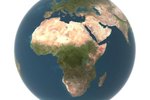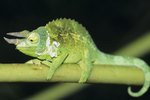Whether you see them in a documentary, zoo or pet store, basilisks are always eye-catching. Known for their ability to run across the surface of the water, basilisks are incredible lizards that seem to come from a different planet. Indeed, the males of the species resemble dragons, as they are adorned with impressive dorsal crests. Despite this otherworldly nature, they do reside on Earth, and can be found if you're familiar with their habitat.
Geographic Range
The basilisks, which are represented by four species in the genus Basiliscus, are found exclusively in the New World. The northern limit of the group’s range is Mexico, where the striped basilisk (Basiliscus vittatus) is found. The other subspecies live throughout Central America, as far south as Panama in the case of the iconic green basilisk (Basiliscus plumifrons) and Columbia in the case of the red headed and common basilisks (Basiliscus galeritis and Basiliscus basiliscus respectively).
Altitude
In most cases, basilisks will reside between sea level and 2,000 feet. This is not a hard and fast rule though, and basilisks have been found twice as high on occasion. This should not be surprising, given their preference for living near the water.
Climate and Biogeography
Basilisks inhabit the Neotropic ecozone. This zone, which stretches from south Florida to southern Brazil, is characterized by year-round warm temperatures and high rainfall. This ecozone contains the Amazon rain forest, which means that the Neotropic ecozone has more tropical rain forest than any other ecozone in the world. Though basilisks aren’t found in the Amazon rain forest, their Central American rain forest habitat is very similar to it. This region contains some of the highest biodiversity on the planet, as is evident by these water-walking lizards.
Microhabitat
Basilisks inhabit riparian areas, which are composed of rivers or streams and the adjacent forests. Riparian habitats offer a number of advantages for basilisks, and they have evolved to thrive in these habitats. Basking opportunities abound near rivers, as the river provides a break in the canopy, which allows sunlight to penetrate to the ground. Further, many insects reproduce in the water, and basilisks benefit from this bounty.
These advantages come with significant risks though; many larger predators frequent riparian habitats. To combat this, basilisks have evolved great speed and specialized scales on their feet which allow them to walk across the surface of the water to flee.





